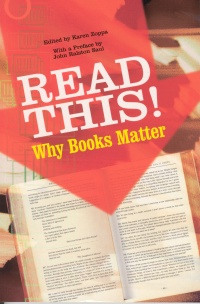| ________________
CM . . .
. Volume X Number 12. . . . February 13, 2004
Read This! Why Books Matter is a collection of mostly very reasonable essays wrapped in an unfortunate and unfounded polemic on the putative disappearance of books from school classrooms. As an academic who taught in the schools for thirteen years and who still visits classrooms, and as a contributor to the Manitoba language arts curriculum who has been away from Manitoba for almost three years, I am in a particularly good position to comment on this book. I cannot recommend that libraries spend their money on it because, as a whole, it is misleading. Alas, the book reviewer part of me that looked carefully at the individual articles also sees that some, perhaps many, of the commentators have far more carefully considered points of view. Their comments are lost in the strident tone and message which the editor has chosen as the book's raison d'etre. Let me say first then that books are NOT disappearing from classrooms. To cite Mark Twain on the false announcement of his death, their "demise has been greatly exaggerated." Drop into a school of your choice today, and you, too, will see teachers developing novel studies and giving book talks, and yes, even students reading. And NO, neither the Manitoba government or its teachers nor any other Canadian government has begun to get rid of books. Has the content and curriculum of language arts moved beyond an exclusive emphasis on classical literature? Yes. Most teachers and academics in education now realize that the learning needs of our students should include studying television advertising, reading web sites, writing about their own lives, critiquing films and music videos, for example. I find it interesting that Shakespeare's words "so long lives this, and this gives life to thee" which Zoppa chooses to begin this book actually refers to the play--meant to be seen on a stage! And indeed, the newest language arts curricula include a number of skills which can be developed using a variety of media. Predicting ability, for example, might be introduced using a film, stopping it after a few minutes and asking students what they think might happen next. The teacher could reinforce predicting by having students next read the first few paragraphs of a short story and then offer suggestions about how the story will end. We know that our students live in a world dominated by visual images but also that they will have to be sophisticated readers and creators of print. It seems to me that what is of most importance here is the development of critical ability applied to all media. The individual essays in Read This! Why Books Matter often support this balanced approach to modern language arts teaching. Of the 17 essays, very few are written by school teachers and none at all by professors of language arts education. Most contributors are English professors, philosophers and authors. John Ralston Saul writes in the preface, "Philosophy and literature are far more useful than turning a machine on and off" (I love philosophy and literature--but we also need people with practical skills, I think) and the editor, Karen Zoppa, sounds a call to arms that includes the equating of reading literature with the preservation of Canadian democracy (How about watching great films or learning how to become a social activist by using the Web?). In fact, by the end of the book, the editor has shifted her attack from the perils of schools without literature to the licensing of teachers to teach at any level "This flaw in the system is a serious one that needs to be addressed" (original emphasis). Apparently, her ambitions to change education do not stop with this current campaign. Of the rest of the essays, however, I note a much more balanced set of ideas which might be summarized as: literature of course--but other topics too. Phyllis Webster talks about the effect on her class of a video from Amnesty International. Bob Haverluck contributes cartoons for 'readers' to interpret. Rhian Brynjolson states that "the value of traditional print literacy in a child's educational development need not be pitted against the value of modem multi-media literacy as an either/or proposition" (p. 63). Other essays are defences of the place of literature or novels or books in schools. I accept their point that books are important, but these are not new or original ideas. Apparently, these writers have bought the argument of the editor and her organization MACRO (Meaningful Assessment and Curricular Reform Organization) that language arts teaching is at risk. I don't buy it--and I would discourage anyone else from buying this book. Read the new curriculum instead (it's available online and in hard copy). Not Recommended. Deborah Begoray, in addition to being a professor of language arts, is the Chair of the Dept. of Curriculum and Instruction in the Faculty of Education, the University of Victoria in Victoria, BC.
To comment
on this title or this review, send mail to cm@umanitoba.ca.
Copyright © the Manitoba Library Association. Reproduction for personal
use is permitted only if this copyright notice is maintained. Any
other reproduction is prohibited without permission.
NEXT REVIEW |TABLE OF CONTENTS FOR THIS ISSUE
- February 13, 2004.
AUTHORS
| TITLES | MEDIA REVIEWS
| PROFILES
| BACK ISSUES
| SEARCH | CMARCHIVE
| HOME |
